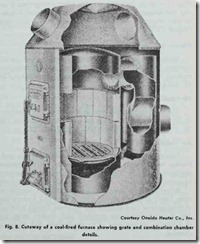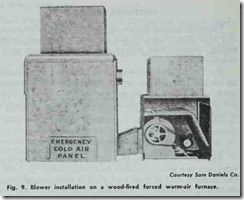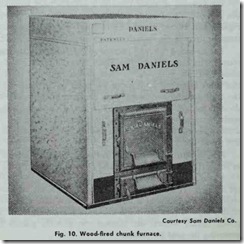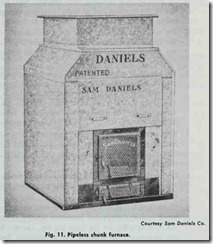CHIMNEY
The chimney used with a coal-fired furnace should be of suffi cient height and area to meet the requirements of the furnace. For best results, only the furnace should be connected to the chimney. Read the section CHIMNEYS in Chapter 11 (GAS FIRED FURNACES).
Chimney Troubleshooting
The chimneys used with coal-fired furnaces are basically the same as those used with gas-fired and oil-fired units. Read the section CHIMNEY TROUBLESHOOTING in Chapter 11 (GAS FIRED FURNACES) for a description of common chimney prob lems and suggested remedies are:
BASIC FURNACE COMPONENTS
The basic components of a coal-fired forced warm-air furnace
1. Automatic controls,
2. Furnace grate,
3. Heat exchanger,
4. Coal stoker,
5. Blower and motor.
Each of these components is described in the sections that follow. Additional information is contained in Chapter 10 (FUR NACE FUNDAMENTALS) and the various chapters in which furnace controls and fuel burning equipment are described.
Automatic Controls
The automatic controls of a coal-fired furnace which uses a stoker to feed the coal are shown in Fig. 7. This control system is very similiar to the one used for an oil burner except for the automatic timer included with the stoker relay and transformer. During the heating season, the fire of a coal furnace must burn continually. The timer is a device designed to operate the coal stoker for a few minutes every hour or half hour in order to keep the fire alive during those periods when little heat is required.
A stack thermostat or similar device is recommended for use with stokers in areas subject to electric power failures. An electric power failure will shut down the stoker. If the shutdown period is long enough, the fire will die for lack of fuel. When the elec tricity comes on again, the stoker will feed coal to a cold fire pot. A stack thermostat or light sensitive electronic device will monitor the stack heat or fire, and prevent stoker operation when the fire is out.
A blower fan control is generally included with most forced warm-air furnaces. Many manufacturers will also provide a hand operated draft control with a coal-fired furnace. Electrically oper ated dampers for draft control are generally available, but at extra cost.
The operation of a furnace is controlled by the room thermostat. In heating systems in which a coal-fired furnace is used, the thermostat opens or shuts dampers to increase or decrease the supply of air to the fire. When the supply of air is increased, the fire becomes hotter and the amount of heat generated by the furnace is increased. Decreasing the supply of air to the fire has the opposite effect. Older coal-fired fu rn aces are not controlled by a room thermostat. Hand operated dampers were used instead.
Furnace Grate
An essential part of any coal-fired f u rnace is the metal grate on which the fuel is burned (Fig. 8). The grate should be designed to allow sufficient primary air to pass upward through the fuel bed for the combustion process. The ashes will drop to the ashpit below through the same openings when the grate is shaken.
There should be a metal heat transfer surface (heat exchanger) of sufficient size above the fire to transfer the heat from the com bustion process to the water or air in the heating system.
Coal Stoker
A coal stoker is a device used to automatically feed coal to a coal-fired furnace or boiler. See Chapter 3, Volume 2 (COAL FIRING METHODS) for additional information about coal stokers.
Hand Firing Methods
The method used to hand fire a furnace will depend largely upon the type of solid fuel used in it. Coke and the various types of coals each have their own special hand firing methods. Some of these firing methods are described in Chapter 3, Volume 2 (COAL FIRING METHODS).
Blower and Motor Assembly
The blowers used on coal furnaces are the same centrifugal types found on gas, oil, and electric forced, warm-air furnaces. The blowers are usually installed on either side of the furnace (Fig. 1) or at the back (Fig. 9). The latter arrangement is especi ally recommended for wood burning and multi-fuel furnaces. A detailed description of blowers and blower motors is included in Chapter 11 (GAS-FIRED FURNACES).
Blower Adiustment
Instructions for making blower adjustments can usually be obtained from the furnace manufacturer. A brief description of methods used to make blower adjustments is included in Chapter 11 (GAS-FIRED FURNACES).
Air Filter
The number, size, and type of air filter will be recommended by the furnace manufacturer in the specifications. See also Chapter 14, Volume 3 (AIR CLEANERS AND FILTERS).
Air Conditioning
One method of adding summer air conditioning to a coal-fired heating installation is to install a separate and independent air conditioning system. This is expensive, because it includes the equipment and separate ducts, but it avoids many complications.
If you are considering the idea of adding air conditioning at some future date, you should select a solid fuel furnace capable of meeting your cooling needs. For example, Oneida All-Fuel and Two-in-one furnaces are equipped with blowers large enough to handle up to four tons of air conditioning and electronic air cleaning.
MULTI-FUEL FURNACES
Furnaces designed for use with more than one fuel are avail able from some manufacturers for use in residential warm-air heating systems. Both gravity and forced warm-air units are manufactured.
The Oneida All-Fuel furnace will burn any type of combusti ble material (coal, oil, gas, wood). It is designed to burn coal and wood, oil and wood, or gas and wood at the same time. The cast iron grates allow the burning of anthracite coal, bituminous coal, or wood.
WOOD-FIRED FURNACES
Furnaces are available that burn wood in combination with other fuels (see above), or which burn only wood (Figs. 9 and 10). One standard cord of good hard wood is approximately equal to the heating equivalent of 200 gallons of fuel oil or one ton of coal.
The burning of wood requires a furnace built specifically for this purpose. The Daniels gravity warm-air furnaces illustrated in Figs. 9 and 10 are constructed of steel with fire doors and rec tangular firepots big enough to burn large chunks of wood.
The so-called “chunk” furnace in Fig. 9 has a plate grate with round holes and slotted holes. Each time the furnace is fired, the wood coals are pulled to the front of the grate and stirred up so that there is a draft up through the holes in the plate. By closing the draft door located in the large fire door and opening the draft door in the ash pit door, a draft is forced up through the wood coals to complete their burning. For general firing the ash pit draft door is closed and the fire is regulated by the draft door in the fire (feed) door.
Forced warm-air wood-fired furnaces are also available for use in residential heating systems. The Daniels furnace shown in Fig. 11 is available in capacities ranging from 100,000 to 400,000 Btu (at bonnet). These units contain three large filters and the air is circulated by means of a large, low velocity fan. One advantage of this type of furnace is the provision for gravity heat. When a power failure occurs, the furnace can provide gravity heat by removing the cold air panels.




